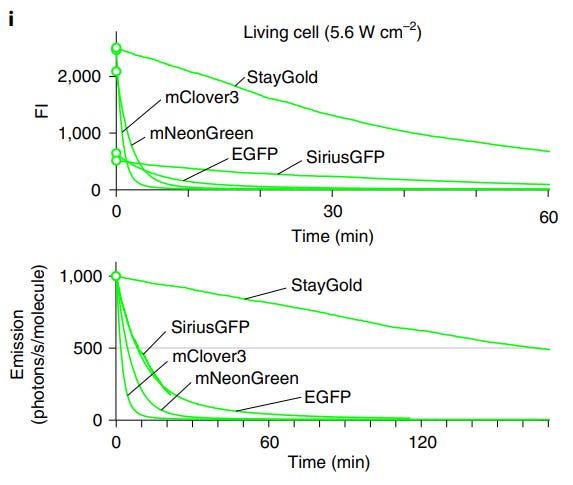This Protein is 10x Better Than GFP: Codon Index #46
Plus: A synthetic nerve & CRISPR-carrying nanoparticles pass the blood-brain barrier.
Hello. A jellyfish protein is far brighter and more photostable than any other GFP. Synthetic nerves, built from biological components, could be used for neural implants. And CRISPR nanoparticles travel through the blood-brain barrier, tripling the life span of mice with glioblastoma tumors.
Note: This list is not exhaustive. Included papers are a proxy of two things: a) Did I see the paper and b) Does the paper seem worth a skim, at least. I often exclude papers published in predatory journals. If you’d like to ensure that I see your paper, please send it to me.
Jellyfish Light
A new green fluorescent protein, plucked from the Cytaeis uchidae jellyfish that swims in the waters outside Sendai City, Japan, is an order of magnitude more stable than mNeonGreen, EGFP, and probably any other version of GFP that you’ve ever used. It’s also far brighter. The protein, which was slightly tweaked in the lab, is called StayGold. It was reported in Nature Biotechnology this morning.

There is, normally, an inverse relationship between a protein’s brightness and photostability. Very bright proteins, often, are riddled with pockets into which oxygen seeps. This helps to make them brighter. Oxygen, at the same time, makes proteins less photostable. StayGold seems to have neither of these problems.
In one experiment, the researchers fused StayGold to a nanobody that targets the SARS-CoV-2 Spike protein. They expressed the fused protein in VeroE6 cells (from a monkey’s kidney) and then infected those cells with SARS-CoV-2. Beneath a microscope, for 10 minutes or more, the researchers watched SARS-CoV-2 viruses physically assemble within the infected cells. StayGold is so bright, and so stable, it can accommodate these time-lapse, “watch a virus get made” sorts of experiments. Just incredible.
Read more at Nature Biotechnology.
Synthetic Nerve
Artificial nerves, built using biological components, can transmit information over centimeter-long distances. Light-sensitive proton pumps, taken from Halorubrum sodomense bacteria first discovered in the Dead Sea, are embedded at one end of the nerve. Upon light stimulation, the synthetic neuron releases neurotransmitters from its own cell to the next. Each cell is connected, in a line, by “nanolitre aqueous droplets and hydrogel fibres.”
These synthetic neurons could be useful for bio-based computing or for neural implants. This is the latest paper from Hagan Bayley, whose research group previously pioneered nanopore technology for long-read DNA and polymer sequencing.
Read more at Nature Chemistry.
Breaking Barriers
A nanocapsule containing the Cas9 protein and its guide RNA can travel through the blood-brain barrier and specifically target glioblastomas.
The nanoparticles are built by coating Cas9 in a positively-charged molecule, and then linking each of those molecules together with a cross-linking ‘glue.’ These ‘CRISPR balls’ are then coated in a layer of PEG. The result is a small sphere, about 30 nanometers across, that is just large enough to house one Cas9 protein and its guide RNA. When targeted to glioblastoma tumors in mice, the CRISPR nanoparticles edited the PLK1 gene in 38.1 percent of cells. The treatment nearly tripled the survival time of mice with the tumors, from 24 to 68 days on average.
Read more at Science Advances.
Other Papers
(↑ = recommended article, * = open access, † = review article, )
Basic Research
*Supercoiling-mediated feedback rapidly couples and tunes transcription. Johnstone CP & Galloway KE. bioRxiv (preprint). Link
Biomanufacturing
↑Dynamic modulation of enzyme activity by synthetic CRISPR–Cas6 endonucleases. Mitkas AA, Valverde M & Chen W. Nature Chemical Biology. Link
*†Microbial genetic engineering approach to replace shark livering for squalene. Patel A…Matsakas L. Trends in Biotechnology. Link
*†Innovation trends in industrial biotechnology. Nielsen J…Petranovic D. Trends in Biotechnology. Link
Optimization of Heterologous Glucoraphanin Production In Planta. Barnum CR…Shih PM. ACS Synthetic Biology. Link
†Biomanufacturing design: reducing the environmental burden. Whitford B, Jones D & Kinnane S. Current Opinion in Biotechnology. Link
Cell Engineering
Transforming primary human hepatocytes into hepatocellular carcinoma with genetically defined factors. Jiang Z…Li Y. EMBO Reports. Link
Generation of 3D lacrimal gland organoids from human pluripotent stem cells. Hayashi R…Nishida K. Nature. Link
Computational Tools & Models
*DNAzymeBuilder, a web application for in situ generation of RNA/DNA-cleaving deoxyribozymes. Mohammadi-Arani R…Ponce-Salvatierra A. Nucleic Acids Research. Link
*LoopGrafter: a web tool for transplanting dynamical loops for protein engineering. Planas-Iglesias J…Bednar D. Nucleic Acids Research. Link
*A hierarchy of biomolecular proportional-integral-derivative feedback controllers for robust perfect adaptation and dynamic performance. Filo M, Kumar S & Khammash M. Nature Communications. Link
*Dichotomous feedback: a signal sequestration-based feedback mechanism for biocontroller design. Sootla A…Papachristodoulou A. Journal of the Royal Society Interface. Link
An online notebook resource for reproducible inference, analysis and publication of gene regulatory networks. Guebila MB…Quackenbush J. Nature Methods. Link
CRISPR & Genetic Control
*Rational guide RNA engineering for small-molecule control of CRISPR/Cas9 and gene editing. Liu X…Zhou X. Nucleic Acids Research. Link
*Synthetic Translational Regulation by Protein-Binding RNA Origami Scaffolds. Nguyen MTA, Pothoulakis G & Andersen ES. ACS Synthetic Biology. Link
Genetic Circuits
*Riboswitch-inspired toehold riboregulators for gene regulation in Escherichia coli. Wang T & Simmel FC. Nucleic Acids Research. Link
Medicine & Diagnostics
↑*Nasally-delivered interferon-λ protects mice against infection by SARS-CoV-2 variants including Omicron. Chong Z…Diamond MS. Cell Reports. Link
†Regulatory Considerations for Clinical Trial Applications with CRISPR-Based Medicinal Products. Anliker B…Sebe A. The CRISPR Journal. Link
*Insulated expression of periplasmic uricase in E. coli Nissle 1917 for the treatment of hyperuricemia. He L…Hu Y. bioRxiv (preprint). Link
Reduction of mtDNA heteroplasmy in mitochondrial replacement therapy by inducing forced mitophagy. Fan X…Luo S. Nature Biomedical Engineering. Link
Engineering Antisense Oligonucleotides as Antibacterial Agents That Target FMN Riboswitches and Inhibit the Growth of Staphylococcus aureus, Listeria monocytogenes, and Escherichia coli. Traykovska M & Penchovsky R. ACS Synthetic Biology. Link
Plants
*†The EU’s GM crop conundrum. Garcia-Alonso M…Podevin N. EMBO Reports. Link
↑Targeting a gene regulatory element enhances rice grain yield by decoupling panicle number and size. Song X…Yu H. Nature Biotechnology. Link
Protein & Molecular Engineering
Computational design of mechanically coupled axle-rotor protein assemblies. Courbet A…Baker D. Science. Link
*Novel sarbecovirus bispecific neutralizing antibodies with exceptional breadth and potency against currently circulating SARS-CoV-2 variants and sarbecoviruses. Wang Y…Huang J. Cell Discovery. Link
Tools & Technology
↑*Redesigning regulatory components of quorum-sensing system for diverse metabolic control. Ge C…Yuan Q. Nature Communications. Link
↑*helixCAM: A Platform for Programmable Cellular Assembly in Bacteria and Human Cells. Chao G…Church GM. bioRxiv (preprint). Link
*Development of NanoLuc-targeting protein degraders and a universal reporter system to benchmark tag-targeted degradation platforms. Grohmann C…Feltham R. Nature Communications. Link
*A loss-of-adhesion CRISPR-Cas9 screening platform to identify cell adhesion-regulatory proteins and signaling pathways. de Rooij M.F.M…Spaargaren M. Nature Communications. Link
Miscellaneous
*Bottlenecks and opportunities for synthetic biology biosafety standards. Pei L, Garfinkel M & Schmidt M. Nature Communications. Link
More soon,
— Niko // @NikoMcCarty // niko@codonmag.com

